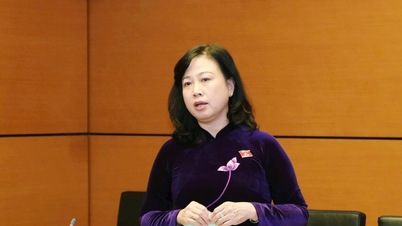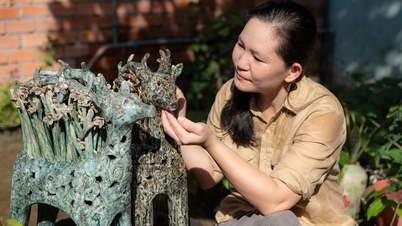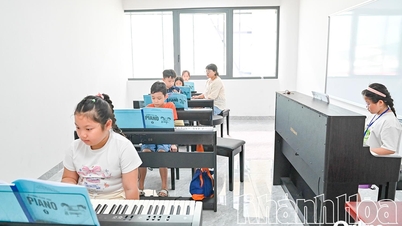 |
| Doctors at Dong Nai General Hospital check the health of an elderly stroke patient. Photo: Hanh Dung |
While the "golden population" structure is an advantage for Vietnam in general and Dong Nai in particular to attract foreign investment and develop socio -economy, the risk of population aging is a challenge, requiring the rapid implementation of solutions to respond.
Increased life expectancy, low birth rate
Speaking at the World Population Day Rally held last July in Hanoi, Minister of Health Dao Hong Lan pointed out the difficulties and challenges in population work in Vietnam today.
First of all, the total fertility rate has dropped to its lowest level in history and is expected to continue to decrease in the following years. If in 2022, the total fertility rate of Vietnamese women was 2.01 children/woman, by 2024 it will have dropped to only 1.91 children/woman. The gender imbalance at birth, although controlled, is not stable and remains high at 111.4 boys/100 girls, which may cause some consequences in the future such as the situation of "too many boys, not enough girls".
The average life expectancy of Vietnamese people in 2024 is 74.7. Although life expectancy has increased, the number of healthy years from birth of Vietnamese people is only about 65 years. The stature, physical strength, and quality of life of people in remote areas and ethnic minority areas are still limited compared to urban and delta areas.
In Dong Nai, the difficulties and challenges in population work have also been pointed out with many "telling" numbers. Dong Nai is one of 13 provinces and cities in the country with low birth rates. The average life expectancy of Dong Nai people in 2024 is 76.2 years old; the rate of people aged 65 and over is 9.7%.
Doctor Nguyen Vo Chien, Department of Cardiology - Geriatrics, Long Khanh Regional General Hospital, said: Every day, the department receives and treats 80-90 elderly patients. Diseases that the elderly often suffer from include: high blood pressure, diabetes, kidney failure, heart failure... Among them, many serious cases require frequent hospitalization and long-term treatment.
Health experts point out that Vietnam is undergoing major demographic changes, from a changing population structure to new fertility trends. Vietnam has the largest young population ever, but is also preparing for a future where by 2036, more than 20% of the population will be aged 60 or older. These trends require adaptive, comprehensive and visionary policies to protect reproductive rights and support families at all stages of life.
Vietnam entered the aging population phase in 2011 when the proportion of people over 60 years old reached about 9.9% of the population. By 2023, this proportion was 14.3%, equivalent to more than 14 million people. It is forecasted that by 2050, it will increase to about 27%, with nearly 30 million elderly people.
Need for synchronous and feasible solutions
Mr. Tran Minh Hoang (33 years old, living in Tran Bien ward) shared: He is working at a private company. Although his family has urged him many times, he still has no intention of getting married and having children. Because according to Mr. Hoang, there are many things to worry about when starting a family. First is the issue of housing, stable job, income, then living expenses, health care when his wife is pregnant and gives birth. Next is the issue of school, children's education and many other concerns.
It can be said that if there are no urgent and synchronous solutions to encourage young people to get married and have children, in the near future, Vietnam will face the risk of "getting old before getting rich". The high rate of elderly people will put pressure on the health care and social security systems...
To cope with population aging, according to Minister of Health Dao Hong Lan, the ministry is focusing on developing the Population Law and the Target Program for Health Care, Population and Development for the period 2026-2035. The aim is to ensure social security, health, and equality for all people with the principle of taking people as the center, which is the goal of the country's sustainable development, shifting the focus of population policy from family planning to population and development.
In the Draft Law on Population submitted to the Government for submission to the National Assembly for comments and approval at the 10th Session (held in October 2025), the Ministry of Health proposed a number of contents such as: prioritizing support for pregnant and childbirth women; solutions to improve population quality; building and developing support facilities and care for the elderly; developing human resources for elderly care; measures to implement pre-marital counseling and health check-ups and other support measures and policies to maintain replacement fertility. At the same time, reduce gender imbalance at birth and bring the sex ratio at birth to a natural balance, adapt to population aging and improve population quality.
The Ministry of Health recommends that relevant ministries, branches, and People's Committees of provinces and cities continue to pay attention to directing, leading, and ensuring resources for population work, especially in the context of changing two-level local governments.
Hanh Dung
Source: https://baodongnai.com.vn/xa-hoi/y-te/202508/ung-pho-voi-gia-hoa-dan-so-a350cf5/





































































































![Dong Nai OCOP transition: [Part 2] Opening new distribution channel](https://vphoto.vietnam.vn/thumb/402x226/vietnam/resource/IMAGE/2025/11/09/1762655780766_4613-anh-1_20240803100041-nongnghiep-154608.jpeg)













Comment (0)